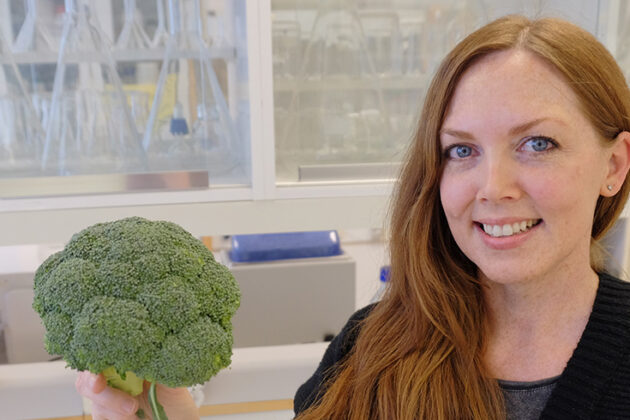Broccoli keeps best in the fridge

Broccoli is full of healthy vitamins and plant materials. But it must be kept properly for it to hold on to the good nutrients.
Temperature and light conditions are important for broccoli’s health-giving constituents and affect its smell, taste and appearance. Researchers at Nofima have recently taken a closer look at how broccoli keeps best when stored. It keeps best at fridge temperatures.
Storage affects quality
“Many consumers are interested in their health, and it’s important to find out what helps ensure products that contain the highest levels of healthy constituents possible. Broccoli is a fantastically healthy and nutritious vegetable. It contains more vitamin C than oranges and is also rich in vitamins A, K, and E, as well as folate. In addition, it is a good source of iron, calcium, potassium and several plant compounds that can help prevent disease,” says Sidsel Fiskaa Hagen, a researcher at Nofima.
Storage conditions can have a huge impact on the health properties of broccoli. The harvested broccoli is still alive, and its chemical composition can change in reaction to its surroundings. Nofima researchers conducted experiments using different temperature and light conditions to look at how storage affects the quality of broccoli. The goals are that consumers get the best and healthiest broccoli possible and to reduce waste to a minimum in the wholesale link and shops.
“We have studied broccoli over a storage period of 10 days at various temperatures and with plain white light, combinations with UV tubes and storage in the dark. We wanted to find out how these conditions affect the content of vitamin C and important plant compounds such as flavonoids and glucosinolates. Flavonoids and glucosinolates have been shown good effects on preventing cancer and cardiovascular disease, among other things,” she says.
The right light and temperature are important
The experiments showed that the most important factor with respect to keeping the nutritional content, and quality otherwise, is storage temperature.
“Broccoli should preferably be stored at a temperature between 0-4 °C. But we have seen that light also has an impact, especially if the temperature rises. The experiments showed that addition of light yields a higher content of glucosinolates, while these plant compounds otherwise remain at a fairly stable level during storage. Flavonoid levels increase during storage, andadding white light combined with UV-B contributes to further flavonoid increases,” says Fiskaa Hagen.
“Vitamin C decreases during storage and the content falls faster the higher the temperature,” says the researcher. However, she adds that some of this loss can be reduced if the broccoli is exposed to light.
“The general advice is that broccoli should be kept fridge cold and that the cooling chain should not be broken.” Unfortunately, broccoli is often kept at room temperature in shops. “In these circumstances it should at least get light,” she says.
Broccoli revives in water
Fiskaa Hagen advises ordinary consumers to store broccoli in the fridge; preferably, wrapped in plastic.
“If it has already become limp, you can cut the stalk and put it in water. The broccoli head is in fact a cluster of flowers and all the tiny green buds on top are actually flower buds. Like other flowers it will revive when it gets water,” she reveals.
Broccoli is a good model plant
The researchers also studied how biochemical processes inside the broccoli are affected during storage, right down to what happens at a genetic level.
“As far as we know, this has not been done with broccoli before. These methods help us better understand what is going on during storage. We do not just see the end results, we also understand why we are getting these results. This makes it easier to determine the best storage conditions. We may also discover other important factors that we can study,” she explains.
Broccoli was selected as the model plant in the study because it contains so many different nutrients. Broccoli is also important for the food industry because while the demand for it is high, its short shelf life presents extra challenges.
“We cannot automatically relate the results from this study to other vegetables, but they do give us a good idea of what might be interesting to look at more closely when it comes to other vegetables. This is important basic knowledge, which we can bring with us into other projects,” says Sidsel Fiskaa Hagen.
Does well in the north
As part of the same project, researchers also conducted an extensive experiment involving cultivating broccoli in several locations in Europe, from Tromsø in the north to Spain in the south.
“Over three years, the project’s researchers studied how the climatic factors light and temperature affect the quality of broccoli. The experiment has provided many answers. Perhaps the most important is that a cold period before harvesting produces more vitamin C. In other words, broccoli is well-suited to cultivation in the cold, Nordic climate,” says senior researcher Gunnar B. Bengtsson, who headed the project.
Contact person
Topics
Vegetables
